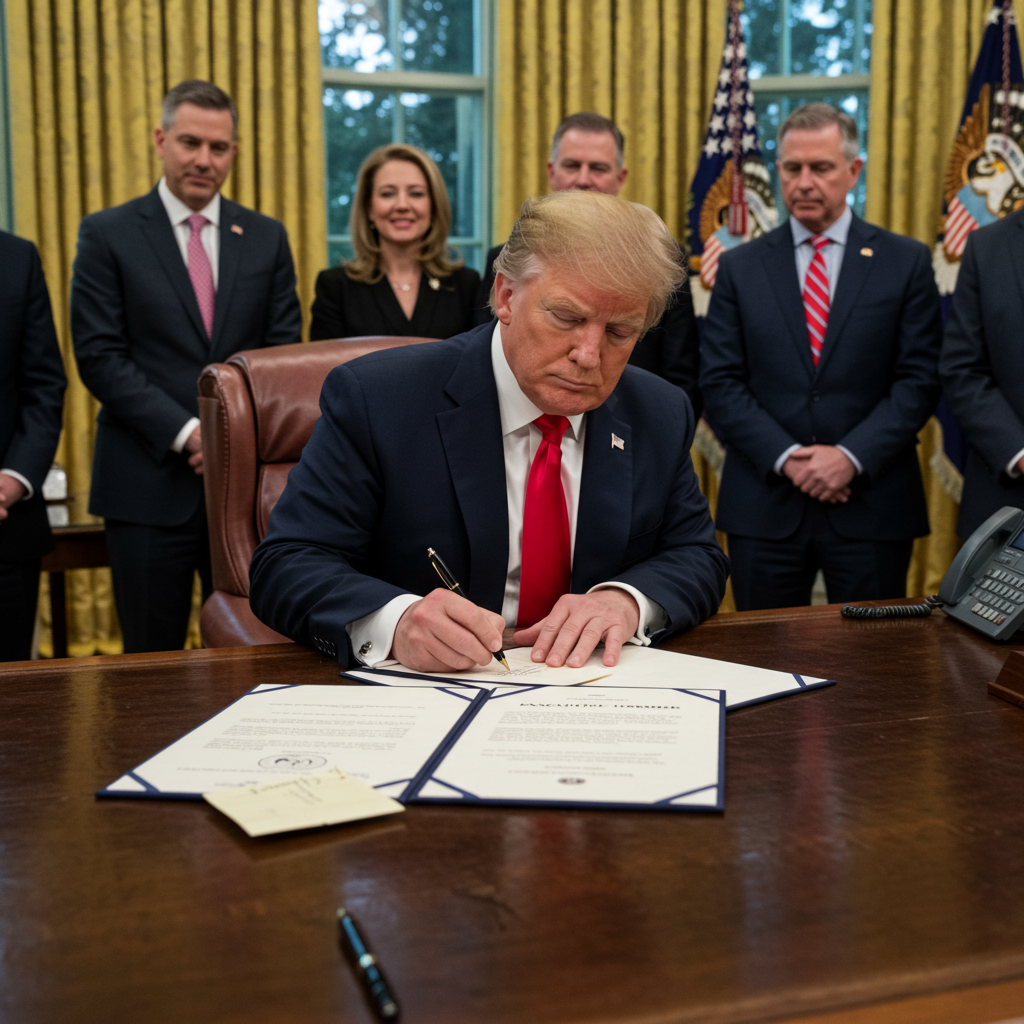Trump Escalates Trade Policy with Massive Tariff Hike
In a significant escalation of his trade agenda, former US President Donald Trump has signed an order to double the tariffs on steel and aluminum imports into the United United States. The move increases the import tax rate from 25% to a substantial 50%, effective immediately as of a recent Wednesday. This marks the second significant hike in import taxes on these crucial metals since March, sending shockwaves through global markets and domestic industries alike.
The sweeping tariff increase impacts metals vital for a wide range of products, from automobiles to food packaging. While framed by the administration as a measure to protect American industry, critics warn of severe repercussions, including potential damage to foreign steel producers, a high risk of retaliatory tariffs from trade partners, and punishing costs for American businesses that rely on imported metals.
Why the Dramatic Increase? Inside Trump’s Rationale for Boosting Tariffs
According to President Trump, the primary objective behind doubling the tariffs is to safeguard the future of the American steel industry and strengthen national supply chains under the authority granted by Section 232 of the Trade Expansion Act, which addresses imports deemed a threat to national security. The intention is to make the tariff rate so prohibitively high that US businesses are compelled to source their materials domestically, effectively preventing other nations from “stealing” the industry.
This latest action follows Trump’s decision in March to eliminate previously granted tariff exemptions for certain imports and allied countries, which he argued had diluted the effectiveness of the initial protections. The administration points to the first term’s 25% steel and 10% aluminum tariffs as having spurred job growth and investment in the domestic metals sector, claiming billions in new mill investments and a significant reduction in imports from 2016 to 2020. They cite data suggesting domestic steel and aluminum capacity utilization has declined in recent years, arguing this threatens the nation’s ability to meet defense and infrastructure needs during emergencies. Furthermore, administration reports and some economic analyses suggest that tariffs can strengthen the economy, promote reshoring, and have minimal impact on overall consumer prices.
Mounting Criticism and Economic Warnings: The Hefty Price Tag for US Businesses and the Economy
Despite the administration’s justifications, the tariff hike has drawn sharp condemnation from economists and critics who argue the economic downsides outweigh the benefits. They contend that tariffs on intermediate inputs like steel and aluminum significantly raise production costs for US manufacturers, making them less competitive.
A 2020 analysis of Trump’s initial tariffs estimated that while they might have created around 1,000 jobs in the steel sector, they resulted in the loss of approximately 75,000 jobs across other sectors, including manufacturing and construction. Experts caution that doubling the tariffs now could lead to even more drastic job losses, describing the policy as economically inconsistent and potentially harmful to downstream industries already facing challenges. Rising prices for businesses and consumers are also anticipated as a direct consequence of the increased import costs.
Real-World Impact Hits Home: US Businesses Reel from Doubled Import Costs
The impact of the intensified tariffs is already being felt by American businesses that depend on specific types of imported steel and aluminum. Many firms, blindsided by the sudden announcement, described the situation as one of “chaos” and uncertainty, initially hoping the drastic measure would be temporary or merely a negotiating tactic.
For companies like Independent Can Co. in Maryland, which imports European steel for decorative tins, the initial 25% tariffs had already forced them to halt investments and raise prices, fearing customers might switch to alternative materials like plastic or paper. A 50% rate magnifies this risk.
Similarly, a small manufacturing business in Illinois, Drill Rod & Tool Steels, which imports specialized Austrian steel not produced domestically, saw an expected tariff bill of around $72,000 on a recent shipment suddenly double to almost $145,000 overnight. The shock prompted the company to raise its prices further (by 8%-14%) and even cut worker hours as customers became more cautious with orders. For these businesses, the increased tariffs are “one punch after the other,” creating significant operational and financial strain.
International Backlash and Trade Tensions: Allies and Partners Prepare for Retaliation
The doubling of tariffs is expected to provoke strong negative reactions and potential countermeasures from trading partners worldwide. Major steel exporters to the US, including Canada and Mexico, have voiced strong opposition. Both countries were already preparing responses following the initial March increase.
Canada, the top exporter of steel to the US, views the hike as a direct threat to its industries and jobs, urging decisive action from its government. Mexico, the third-largest exporter, has called the tariffs unsustainable and unfair, noting it imports more steel from the US than it exports and intends to seek an exemption.
The European Union is also seeking an exemption and is engaged in intense discussions with the US, hoping for a rollback of the tariff threat. While immediate retaliation might be tempered by ongoing trade talks, the EU has existing countermeasures totaling €21 billion ready to deploy if no agreement is reached, potentially as early as July 14. Australia has also publicly criticized the move, calling it “unjustified.”
The UK secured a unique carve-out, maintaining its tariff rate at 25% due to ongoing trade negotiations with the US, a development welcomed by the British government. However, UK Steel, representing domestic producers, warned that a 50% tariff would be “catastrophic” for UK exports to the US, potentially leading to cancellations of nearly all orders, highlighting the severity of the measure if not exempted. Despite a shared concern between the US and EU regarding Chinese oversupply in the global steel market, the US tariff approach against allies continues to strain diplomatic and trade relations.
Context: The US Steel Saga Amidst Ownership Controversies
Adding another layer of complexity, the tariff announcement coincided with developments surrounding US Steel and its proposed acquisition by Japan’s Nippon Steel. President Trump announced the tariff hike at a rally alongside claims of a significant investment and partnership between US Steel and Nippon Steel that would ensure no layoffs, no outsourcing, and maintain US control, even mentioning bonuses for steelworkers.
However, the situation surrounding US Steel’s ownership has been fraught with uncertainty. A previous $15 billion takeover bid by Nippon Steel was ultimately blocked by the Biden administration on national security grounds, an action Trump himself had also opposed, vowing to block a “foreign company” takeover. The precise nature and final approval of the “partnership” Trump referenced remained unclear at the time of the tariff announcement, adding to the overall volatility in the industry landscape. For many steelworkers, the focus remains on policies that “level the playing field for American manufacturing,” regardless of political affiliation.
Looking Ahead: Uncertainty Persists
The dramatic increase in steel and aluminum tariffs leaves businesses and global markets grappling with significant uncertainty. A central question remains whether this move is a long-term policy shift aimed at fundamentally restructuring supply chains or a tactical maneuver within broader trade negotiations. Regardless of intent, the immediate consequence is disruption, increased costs, and heightened trade tensions.
While the administration champions the tariffs as vital for national security and domestic industrial revival, critics highlight the economic costs and the risk of sparking a wider trade conflict. As companies adjust to the doubled import taxes and trade partners weigh retaliatory measures, the full impact of Trump’s intensified tariff policy on the US economy and global trade relations continues to unfold.
References
- https://www.bbc.com/news/articles/cj3j7z73yv2o
- https://www.theguardian.com/us-news/2025/jun/04/trump-tariffs-steel-aluminum
- https://www.bbc.com/news/articles/cy0k5x21y35o
- https://www.whitehouse.gov/fact-sheets/2025/06/fact-sheet-president-donald-j-trump-increases-section-232-tariffs-on-steel-and-aluminum/
- https://time.com/7290211/trump-doubles-tariffs-steel-aluminum-backlash-experts-canada/



